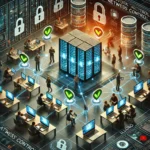One wrong click and your files disappear behind an unbreakable digital lock. A ransom note appears-pay up or lose everything. Scary, right? But here’s the good news: you don’t have to be the next victim. This blog is about staying one step ahead of cybercriminals to prevent a ransomware attack. From learning about ransomware to its defenses, I will arm you with the knowledge of ransomware attack prevention. Because the best way to deal with an attack is to never let it happen in the first place.
Understanding Ransomware
Ransomware Attacks in the digital world are just like kidnapping in real life and here the victim is our data, and to get the victim(here our data) back a ransom must be paid. Ransomware is malware (malicious software) designed to deny users access to their data or systems by encrypting files or locking screens until a ransom is paid. The attackers typically demand payment in cryptocurrency, such as Bitcoin, to maintain anonymity.

How does Ransomware spread?
- Phishing Emails: Attackers send deceptive emails with malicious attachments or links, tricking users into downloading ransomware when interacting with the content.
- Malvertising and Drive-By Downloads: Malicious advertisements can redirect users to compromised websites that automatically download ransomware.
- Exploiting Software Vulnerabilities: Ransomware can spread in the system by exploiting security flaws, particularly in services like Remote Desktop Protocol(RDP)1.
- Network Propagation: Once a single device is infected, some variants of ransomware can move laterally through the network to infect other devices, amplifying the attack of the attacker.
Prevention Strategies
We all have heard the phrase Prevention is better than Cure. This phrase also works in all cases of cyberattacks, you will never know if you can be the next target of the attackers. In the case of a Ransomware attack, some strategies can help to prevent or lessen the effects of the attack.
- Backup your data: It’s always important to have a backup of your data. It is advised to back up using the 3-2-1 Rule. It states that three copies of your data should be on two different types of storage media, with one copy stored offline.
- Update software and systems: Regularly patch and update your operating systems, applications, and antivirus software to fix vulnerabilities that attackers can exploit. Schedule automatic updates to ensure all software is up to date.
- Use Strong Security Measures: Enable firewalls, deploy endpoint security solutions, and implement multi-factor authentication (MFA) to create multiple layers of defense. These measures can detect and block the ransomware from entering the system.
- Be Cautious with Emails and Links: Educate the employees about recognizing phishing attacks and the dangers of clicking through suspicious links.
- Restrict Admin Privileges: Restriction Limits should be imposed on any network so that every authorized person does not let the malware enter the network.
- Disable Unnecessary Remote Access: Close unused Remote Desktop Protocol (RDP) ports and restrict remote access to essential personnel only.
What to do if infected?

Conclusion
In conclusion, remember that a strong defense is the best offense. Prioritize regular updates, empower yourself with cybersecurity knowledge, and embrace safe online habits. Let’s face it: cybersecurity isn’t just an IT issue—it’s a shared mission. Together, we fortify our digital world.
- Remote Desktop Protocol (RDP) is a proprietary network communication protocol developed by Microsoft that enables users to connect to another computer remotely ↩︎


